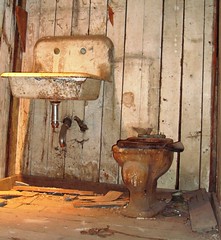I have pages of notes from the Western Veterinary Conference, which I will be sifting through over the next week or so to bring you the most valuable bits. For me, the most personally useful seminars were those on kitty problem potty behaviors, which as you know is something we are dealing with here at the casa.
Dr. Sophia Yin is a veterinary behaviorist and wonderful lecturer who I was fortunate enough to learn from this go round at the conference. She broke down this confusing and frustrating issue into comprehensible patterns and offered a systematic approach for owners and veterinarians to address this, one of the number one reasons cats end up in shelters.
Here is the basic outline for the rationale and approach to kitty potty problems. I will go into more detail about the individual steps in future blogs as I implement the steps myself.
First Things First
Any time a cat is exhibiting inappropriate elimination, a trip to the vet is in order to make sure there is not an underlying cause for the behavior. Cats are tricky, and diseases that might not appear to have anything to do with the bladder can lead to a puddle in your favorite shoes.
Here are just some of the most common medical causes of inappropriate elimination:
- cystitis/FLUTD
- bladder crystals and stones
- diabetes
- hyperthyroidism
- kidney disease
- arthritis (causing pain getting into and out of the box)
The Two Main Types of Problem Pottying: Marking versus Elimination
Marking is a normal feline behavior, a method of communication if you will. Marking can be exhibited by males and females, spayed and neutered. That being said, the behavior is more common in animals that are not fixed, so if they are intact- fix it!
Marking is usually characterized by small amounts of urine on vertical surfaces, sometimes in a delightful fan pee-pattern all over the bottom 4 inches of your wall like a disgusting fleur-de-lys. While they can mark anywhere, it is common for cats to mark doors, furniture, and walls near windows.
I’ve caught Apollo doing this, and it’s just textbook: he backs up to a wall, tail lifted and twitching. Then, squirt and run.
It’s much easier to visualize on a 500 pound lion.
‘Normal’ elimination, on the other hand, is characterized as larger amounts of urine typically deposited on a horizontal surface, like your bedspread, or your husband’s jacket. Normal peeing and pooping but wrong location. In both cases cats may continue to use the litterbox.
The Two Main Causes of Potty Problems
According to Dr. Yin, the main causes of both potty issues fall into one of two categories: Aversion to the litter box, or anxiety.
Litter Box Aversion
What makes a cat not like the litter box? There can be lots of reasons.
 The number one cause is our fault: the box is too dirty. Think about how fastidious the average cat is, then imagine yourself in the typical outhouse at the underfunded state park that hasn’t been emptied in a week, where you can see right down to the pit and all the fetid squalor that lies within. Like people, some cats have a higher tolerance for gross than others, but generally speaking, most of us could be doing a better job.
The number one cause is our fault: the box is too dirty. Think about how fastidious the average cat is, then imagine yourself in the typical outhouse at the underfunded state park that hasn’t been emptied in a week, where you can see right down to the pit and all the fetid squalor that lies within. Like people, some cats have a higher tolerance for gross than others, but generally speaking, most of us could be doing a better job.
They may also have an aversion to the litter type. Much like some of us like purple and other prefer red, some love Drakkar and others swear by Poison; we all have our personal tastes. Cats may have a preference for particular litters and box conformations.
Cats may also have an aversion to the box location, either due to a past traumatic experience, pain associated with elimination, or an annoying dog guarding the entrance to the room. In those cases, it is simply easier to choose a nicer location- like your bedroom floor.
Anxiety
I don’t think it’s a big secret that cats are fairly stress-prone. Anything that can provoke anxiety in their little kitty heads can cause them to start eliminating and marking in untoward places.
Life.
New people. Old people. Strange pets outside. New furniture inside. Your schedule changing. Your schedule staying the same. The garbage truck. Bad country music (ok, maybe I’m projecting there).
Point is, marking and elimination behaviors may be their way of communicating their insecurity to you.
Here’s the Good News
One of the worst things about having a cat with elimination problems is the general feeling of hopelessness people feel. Isn’t that kind of the message people get? “Oh, that’s just cat behavior, that’s what they do.”
When people are confronted with only two choices: Get used to a house that smells of pee or get rid of the cat, many people opt for the second choice. This is how so many cats wind up in shelters or euthanized.
Dr. Yin was very optimistic in her lecture that with a systematic approach to reducing anxiety, improving litterbox acceptability and replacing bad habits with good ones, there is hope for these cats and their owners.
So let’s see how this works, shall we? On Wednesday Apollo gets his yearly dental, along with bloodwork and a urinalysis. Once I have the all clear on that, I’ll start applying these principles here in the house to see if I can get this marking under control.
Photo credits: Bad Kitty, by allygirl520 on Flickr Abandoned, Dirty Bathroom, by StartTheDay on Flickr








Yay! Love it! Can’t wait to hear more about the behavior part of the conference. I saw Dr. Dodman from Tufts last year… he said 65% of shelter animals are euthanized each year, and as you mentioned, the #1 reason for cats to be relinquished is for peeing problems. And yet a lot of vets don’t know how to fully solve this problem… and I agree with Dr Yin, it IS managable, if you have the tools! Can’t wait to see your progress with Apollo. 🙂
Although I don’t have this problem with my cat now (knock on wood!), I have lived with it in the past, so I am really interested in hearing how this progresses! Good luck, Dr. V!
While I am not a cat owner myself, I currently live in house with 5 cats. And being a vet student we get free stuff quite a bit. Well my roomate recently obtained samples of Cat Attract litter which she placed in one of her 4 litter boxes (less than is reccomended I know). She doesn’t have many problems with inappropriate ellimination, except occasionally her one male (he’s black too, go figure). However, the night she put the litter in the box, every cat in house used that box and none of the others…quite nasty to clean up, but impressive none the less. I was impressed and she ended up putting the litter in all the boxes to even it out a bit. Just thought I’d share, it might help someone out ther.
Funny you should mention that, it is part of Dr. Yin’s recommendations! Will be posting about it.
It must also be a law that they urinate on the most difficult things to wash such as a down comforter and one must only discover this after a long day at 3AM while crawling into bed.
This exactly, right down to the down comforter and 3am.
Sigh.
Definitely looking forward to the rest of this series!
The girl cat we have now was mostly raised by her cat father (the mama cat was a bit loopy and ignored the kittens) for her first two months, She was the firstborn and learned how to behave from him. This explains why she lifts her tail, twitches it, thinking she is marking things-especially the piano. Very glad no spray comes out!
I have had this problem in the past, I’m very curious to see how you can stop marking behavior. I resolved it by turning a house cat into a barn cat. (I was unhappy, but the cat was thrilled! He had always wanted to go outside, and he turned out to be an excellent mouser)
I was wondering if they covered (no pun) what to use to clean up after?
This post brought back so many memories! Over 20 years ago (OH MAN! I’m OLD!) my roommate and I each had a cat. One weekend we both went away, and she was delayed coming home due to weather. Well, HER cat showed his annoyance at this abandonment by peeing on MY bed– as well as on my biology textbook, which I could not afford to replace!
It does irk me when cat owners clean the litterbox once every two weeks, then complain when kitty does it elsewhere. What do they expects???
One of the things that surprises people the most is that you should have MORE litterboxes than you have cats. The behaviorist’s “equation” for number of litterboxes in your house is: number of cats(n) +1. So if you have 4 cats, you SHOULD have 5 litterboxes. And clean them at least once a day if not twice.